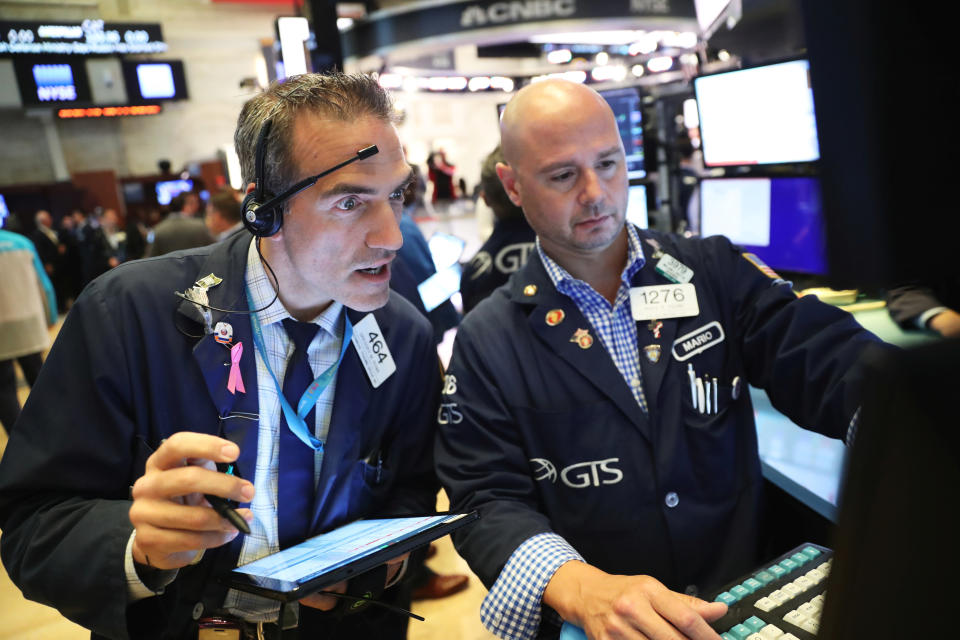Stocks end at record closing highs as Q2 earnings season begins
U.S. stocks ended slightly higher at the end of a choppy session Monday, with each of the three major indices clinching record closes as investors awaited results from major companies set to report quarterly results in the weeks ahead.
The S&P 500 (^GSPC) rose 0.02%, or less than a point, as of market close, hitting a new record close of 3,014.3. The Dow (^DJI) edged up 0.1%, or 27.13 points, while the Nasdaq (^IXIC) increased 0.17%, or 14.04 points. Each of the three major indices fluctuated between gains and losses throughout the session after hitting record intraday highs shortly after market open.
Second-quarter earnings season kicks off this week, with big banks and several major tech names poised to report. Market participants will also be watching for a host of Federal Open Market Committee members set to speak in public remarks this week ahead of the Federal Reserve’s meeting at the end of the month. And elsewhere, e-commerce behemoth Amazon (AMZN) began its two-day Prime Day extravaganza at midnight Monday, in an annual consumer event analysts are expecting will generate record-breaking sales this year.
Banking giant Citigroup (C) reported earnings results before-the bell that topped Wall Street expectations, posting softer-than-expected year-over-year declines in fixed income and investment banking revenue.
Adjusted earnings were $1.83 per share in the second quarter on $18.8 billion in revenue, beating expectations for adjusted EPS of $1.80 per share on sales of $18.52 billion.
[Read more: Citigroup Q2 earnings boosted by fixed income, cost-cutting]
Fixed income revenue fell 4% over last year to $3.32 billion, better than the decline to $2.99 billion expected, while equity markets revenue fell 10% over last year to $1.28 billion. Citi had warned last month that slower trading and investment banking activity would impact second-quarter results.
“We navigated an uncertain environment successfully by executing our strategy, and by showing disciplined expense, credit and risk management,” Citi CEO Michael Corbat said in a statement.
As other companies gear up to report results, investors are widely expecting to see year-over-year decline in corporate earnings amid rising labor costs, softening macroeconomic conditions and uncertainty surrounding global trade.
On an aggregate basis, Wall Street consensus is forecasting an about 2% decline over last year in S&P 500 earnings per share (EPS) during the second quarter, according to an analysis from Goldman Sachs. Companies in the tech and materials sectors are anticipated to post the steepest year-over-year declines in EPS, the analysts noted.
China’s 2Q growth slumps
Meanwhile, U.S. equity traders largely shrugged off new signs of a marked slowdown in economic growth abroad.
Gross domestic product (GDP) for China, the world’s second largest economy, grew at just a 6.2% pace for the quarter ending in June, according to government data released Monday.

This marked the slowest quarterly growth rate since 1992 and a deceleration from a 6.4% pace in the quarter prior, and came even as the Chinese government earlier this year attempted to inject stimulus into the economy through billions of dollars worth of tax cuts. China’s National Bureau of Statistics noted in a statement that the Chinese economy is poised to continue facing downward pressure in the second half of the year, amid an ongoing trade war with the U.S.
Some economists, however, pointed out that China’s quarterly GDP report belied monthly figures for June that beat expectations and hinted at a future pick-up in growth. China’s industrial output rose 6.3% on a yearly basis in June, rising from a 5.2% yearly gain averaged in the first two months of the second quarter. And retail sales in June rose 9.8%, rising from an 8.6% pace in May.
“As in the production data, the June surge in demand is a positive forward-looking indicator,” Carl B. Weinberg, chief international economist for High Frequency Economics, wrote in a note.
—
Emily McCormick is a reporter for Yahoo Finance. Follow her on Twitter: @emily_mcck
Read more from Emily:
Earnings season, Amazon Prime Day – What to know in the week ahead
Tech companies like Lyft want your money – not ‘your opinion’
Follow Yahoo Finance on Twitter, Facebook, Instagram, Flipboard, LinkedIn, and reddit.
Read the latest financial and business news from Yahoo Finance
